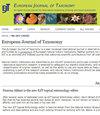On the taxonomic status of Dina ratschaensis Kobakhidze, 1958 with a description of two new species – Dina imeretiensis sp. nov. and D. samegreloensis sp. nov. (Annelida, Hirudinida: Erpobdellidae)
IF 1.1
3区 生物学
Q3 ENTOMOLOGY
引用次数: 0
Abstract
Two species of leeches were described from Georgia in the past, Dina ratschaensis Kobakhidze, 1958 from the Racha-Lechkhumi and Kvemo Svaneti region and Trocheta ariescornuta Grosser, Barjadze & Maghradze, 2021 from the Samegrelo-Zemo Svaneti region. Both species were the only known typical representatives of cave leeches in Georgia. Recently, two more species of the genus Dina R. Blanchard, 1894 have been found in karst caves in this country. These leeches are morphologically similar to D. ratschaensis, from which they differ in the shape of the reproductive system, primarily the shape of the cornua of the genital atrium and the shape and extension of the vasa deferentia and ovisacs, justifying the description of two new species, Dina imeretiensis Grosser, Barjadze & Maghradze sp. nov. from the Imereti region and Dina samegreloensis Grosser, Barjadze & Shavadze sp. nov. from the Samegrelo-Zemo Svaneti region. Data on the cave dwelling invertebrate communities in the studied caves are provided. Molecular data are provided, and a phylogenetic tree based on Cox1 sequences of Dina spp. and related genera is provided and discussed.On the classificationonomic status of Dina ratschaensis Kobakhidze, 1958 with a description of two new species - Dina imeretiensis sp.
格鲁吉亚曾发现两种水蛭:1958年产于Racha-Lechkhumi和Kvemo Svaneti地区的Dina ratschaensis Kobakhidze和Barjadze地区的Trocheta ariescornuta Grosser &Maghradze, 2021年,来自Samegrelo-Zemo Svaneti地区。这两个物种是格鲁吉亚已知的洞穴水蛭的唯一典型代表。最近,在这个国家的喀斯特洞穴中又发现了两个Dina R. Blanchard属的物种,1894。这些水蛭在形态上与鼠尾水蛭相似,它们在生殖系统的形状上有所不同,主要是生殖心房角的形状以及输精管和卵泡的形状和延伸,这证明了两个新种的描述是合理的:Dina imeretiensis Grosser, Barjadze &Maghradze sp. 11 .来自Imereti地区和Dina samegreloensis Grosser, Barjadze &Shavadze sp. 11 .来自Samegrelo-Zemo Svaneti地区。提供了研究洞穴中穴居无脊椎动物群落的数据。提供了分子数据,并根据Dina属及其相关属的Cox1序列建立了系统发育树。
本文章由计算机程序翻译,如有差异,请以英文原文为准。
求助全文
约1分钟内获得全文
求助全文
来源期刊

European journal of taxonomy
ZOOLOGY-
CiteScore
2.30
自引率
8.30%
发文量
173
审稿时长
29 weeks
期刊介绍:
EJT is a fully refereed, international, fully electronic Open Access journal in descriptive taxonomy, covering subjects in zoology, entomology, botany (in its broadest sense), and palaeontology. EJT-papers must be original and adhere to high scientific (content) and technical (language, artwork, etc.) standards. Manuscripts that are clearly substandard in either of these categories will not be sent out for review. EJT is supported by a consortium of European Natural History Institutes, but its scope is global. Both authorship and geographical region of study need not be European. Authors are, however, strongly encouraged to involve European Natural History collections by consulting material or by depositing specimens (e.g. types and figured material) related to their published paper in the collection of a European Natural History Institute.
 求助内容:
求助内容: 应助结果提醒方式:
应助结果提醒方式:


